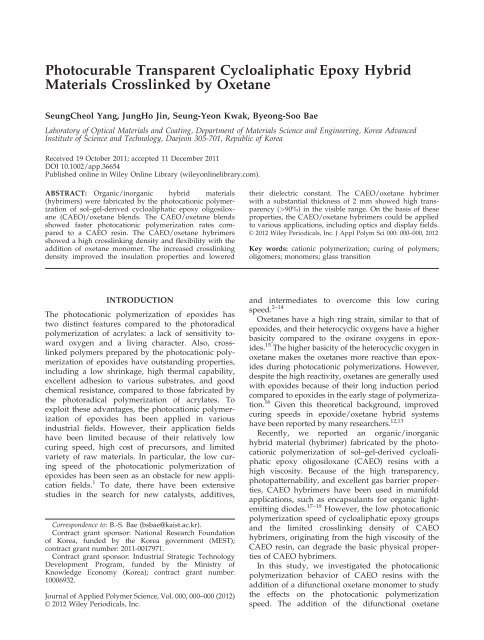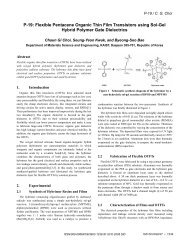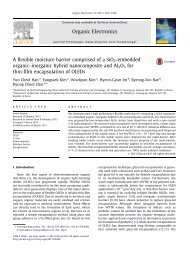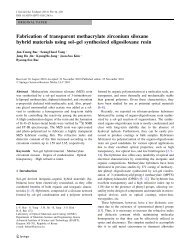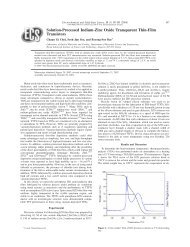Photocurable transparent cycloaliphatic epoxy hybrid materials ...
Photocurable transparent cycloaliphatic epoxy hybrid materials ...
Photocurable transparent cycloaliphatic epoxy hybrid materials ...
You also want an ePaper? Increase the reach of your titles
YUMPU automatically turns print PDFs into web optimized ePapers that Google loves.
<strong>Photocurable</strong> Transparent Cycloaliphatic Epoxy Hybrid<br />
Materials Crosslinked by Oxetane<br />
SeungCheol Yang, JungHo Jin, Seung-Yeon Kwak, Byeong-Soo Bae<br />
Laboratory of Optical Materials and Coating, Department of Materials Science and Engineering, Korea Advanced<br />
Institute of Science and Technology, Daejeon 305-701, Republic of Korea<br />
Received 19 October 2011; accepted 11 December 2011<br />
DOI 10.1002/app.36654<br />
Published online in Wiley Online Library (wileyonlinelibrary.com).<br />
ABSTRACT: Organic/inorganic <strong>hybrid</strong> <strong>materials</strong><br />
(hybrimers) were fabricated by the photocationic polymerization<br />
of sol–gel-derived <strong>cycloaliphatic</strong> <strong>epoxy</strong> oligosiloxane<br />
(CAEO)/oxetane blends. The CAEO/oxetane blends<br />
showed faster photocationic polymerization rates compared<br />
to a CAEO resin. The CAEO/oxetane hybrimers<br />
showed a high crosslinking density and flexibility with the<br />
addition of oxetane monomer. The increased crosslinking<br />
density improved the insulation properties and lowered<br />
their dielectric constant. The CAEO/oxetane hybrimer<br />
with a substantial thickness of 2 mm showed high transparency<br />
(>90%) in the visible range. On the basis of these<br />
properties, the CAEO/oxetane hybrimers could be applied<br />
to various applications, including optics and display fields.<br />
VC 2012 Wiley Periodicals, Inc. J Appl Polym Sci 000: 000–000, 2012<br />
Key words: cationic polymerization; curing of polymers;<br />
oligomers; monomers; glass transition<br />
INTRODUCTION<br />
The photocationic polymerization of epoxides has<br />
two distinct features compared to the photoradical<br />
polymerization of acrylates: a lack of sensitivity toward<br />
oxygen and a living character. Also, crosslinked<br />
polymers prepared by the photocationic polymerization<br />
of epoxides have outstanding properties,<br />
including a low shrinkage, high thermal capability,<br />
excellent adhesion to various substrates, and good<br />
chemical resistance, compared to those fabricated by<br />
the photoradical polymerization of acrylates. To<br />
exploit these advantages, the photocationic polymerization<br />
of epoxides has been applied in various<br />
industrial fields. However, their application fields<br />
have been limited because of their relatively low<br />
curing speed, high cost of precursors, and limited<br />
variety of raw <strong>materials</strong>. In particular, the low curing<br />
speed of the photocationic polymerization of<br />
epoxides has been seen as an obstacle for new application<br />
fields. 1 To date, there have been extensive<br />
studies in the search for new catalysts, additives,<br />
Correspondence to: B.-S. Bae (bsbae@kaist.ac.kr).<br />
Contract grant sponsor: National Research Foundation<br />
of Korea, funded by the Korea government (MEST);<br />
contract grant number: 2011-0017971.<br />
Contract grant sponsor: Industrial Strategic Technology<br />
Development Program, funded by the Ministry of<br />
Knowledge Economy (Korea); contract grant number:<br />
10006932.<br />
Journal of Applied Polymer Science, Vol. 000, 000–000 (2012)<br />
VC 2012 Wiley Periodicals, Inc.<br />
and intermediates to overcome this low curing<br />
speed. 2–14<br />
Oxetanes have a high ring strain, similar to that of<br />
epoxides, and their heterocyclic oxygens have a higher<br />
basicity compared to the oxirane oxygens in epoxides.<br />
15 The higher basicity of the heterocyclic oxygen in<br />
oxetane makes the oxetanes more reactive than epoxides<br />
during photocationic polymerizations. However,<br />
despite the high reactivity, oxetanes are generally used<br />
with epoxides because of their long induction period<br />
compared to epoxides in the early stage of polymerization.<br />
16 Given this theoretical background, improved<br />
curing speeds in epoxide/oxetane <strong>hybrid</strong> systems<br />
have been reported by many researchers. 12,13<br />
Recently, we reported an organic/inorganic<br />
<strong>hybrid</strong> material (hybrimer) fabricated by the photocationic<br />
polymerization of sol–gel-derived <strong>cycloaliphatic</strong><br />
<strong>epoxy</strong> oligosiloxane (CAEO) resins with a<br />
high viscosity. Because of the high transparency,<br />
photopatternability, and excellent gas barrier properties,<br />
CAEO hybrimers have been used in manifold<br />
applications, such as encapsulants for organic lightemitting<br />
diodes. 17–19 However, the low photocationic<br />
polymerization speed of <strong>cycloaliphatic</strong> <strong>epoxy</strong> groups<br />
and the limited crosslinking density of CAEO<br />
hybrimers, originating from the high viscosity of the<br />
CAEO resin, can degrade the basic physical properties<br />
of CAEO hybrimers.<br />
In this study, we investigated the photocationic<br />
polymerization behavior of CAEO resins with the<br />
addition of a difunctional oxetane monomer to study<br />
the effects on the photocationic polymerization<br />
speed. The addition of the difunctional oxetane
2 YANG ET AL.<br />
TABLE I<br />
Formations and Notations of the CAEO/DOX Resins<br />
Sample<br />
Weight ratio<br />
(equivalent molar<br />
ratio)<br />
CAEO<br />
DOX<br />
Catalyst content<br />
(to mixed resin)<br />
CAEO 1.0 (1.00) 0.0 (0.00) 2 wt %<br />
CAEO/DOX10 1.0 (0.71) 0.1 (0.29)<br />
CAEO/DOX20 1.0 (0.56) 0.2 (0.44)<br />
CAEO/DOX30 1.0 (0.45) 0.3 (0.55)<br />
CAEO/DOX100 1.0 (0.20) 1.0 (0.80)<br />
DOX 0.0 (0.00) 1.0 (1.00)<br />
monomer into the CAEO hybrimer was expected to<br />
provide enhancements not only in the overall curing<br />
efficiency but also in the characteristic properties of<br />
the CAEO hybrimer. Multiple tools, such as a<br />
dynamic mechanical analyzer, a room-temperature<br />
mechanical bending test, a source measure unit, and<br />
an impedance/gain analyzer, were used to check<br />
variations in the thermophysical and electrical properties<br />
of the CAEO hybrimer in the presence of oxetane<br />
monomer. On the basis of these improved properties,<br />
we confirmed that the CAEO hybrimer could<br />
be used in various application fields.<br />
EXPERIMENTAL<br />
Preparation of the CAEO/DOX resins<br />
CAEO/DOX resins were prepared to evaluate the<br />
photosensitivity and viscosity of the resins. The<br />
CAEO resin was synthesized via a nonhydrolytic<br />
sol–gel reaction between 0.01 mol of 2-(3,4-<strong>epoxy</strong>cyclohexyl)ethyltrimethoxysilane<br />
(Gelest, Morrisville,<br />
PA) and 0.01 mol of diphenylsilanediol (Gelest) with<br />
a previously reported synthesis method. 17 3-Ethyl-<br />
3{[(3-ethyloxetane-3-yl)methoxy]methyl} oxetane<br />
(DOX; Toagosei, Tokyo, Japan) was mixed with the<br />
CAEO resin, and the weight ratio between the CAEO<br />
resin and DOX is listed in Table I. Triarylsulfonium<br />
hexafluoroantimonate salts of 2 wt% (Aldrich, St.<br />
Louis, MO) was added as a catalyst for the photocationic<br />
polymerization. The formulations and notations<br />
of each resin are summarized in Table I.<br />
Characterization of the CAEO/DOX resins<br />
The viscosity of the resins was measured at 25 C with<br />
a rheometer (DV-III+, Brookfield Engineering Laboratories,<br />
Inc., Middleboro, MA). The photosensitivity of<br />
each resin was characterized by a differential scanning<br />
calorimeter (DSC Q2000, TA Instruments, New<br />
Castle, DE) equipped with a photocalorimeter accessory<br />
(high-pressure mercury lamp, TA Instruments).<br />
Each sample (3–4 mg) was loaded to an aluminum<br />
pan and irradiated by ultraviolet (UV) light under a<br />
dry-air atmosphere. The light intensity was adjusted<br />
to 20 mW/cm 2 , and a light wavelength of 250–650 nm<br />
was transformed to a wavelength of 250–450 nm with<br />
a UV broadband filter.<br />
Fabrication of the CAEO/DOX hybrimers<br />
The CAEO/DOX hybrimers were fabricated by the<br />
photocationic polymerization of CAEO/DOX resins.<br />
The CAEO/DOX resins were irradiated with UV<br />
light for 10 min with a Hg lamp (80 mW/cm 2 , 365<br />
nm, 97453, Oriel Instruments, Stratford, CT) under<br />
an air condition to obtain samples with various<br />
Scheme 1<br />
Fabrication of the CAEO/DOX hybrimer by photocationic polymerization.<br />
Journal of Applied Polymer Science DOI 10.1002/app
PHOTOCURABLE TRANSPARENT CAEO/OXETANE MATERIALS 3<br />
DOX20 hybrimers was measured in a wavelength<br />
range between 300 and 800 nm with a UV–visible–<br />
near infrared spectrophotometer (UV3101PC, Shimadzu,<br />
Kyoto, Japan).<br />
Figure 1 Photo DSC exothermic curves of the CAEO/<br />
DOX resins. [Color figure can be viewed in the online<br />
issue, which is available at wileyonlinelibrary.com.]<br />
dimensions for the measurements of various physical<br />
properties. Sequentially, the UV-cured samples<br />
were thermally cured at 150 C for 2 h under an air<br />
condition for the promotion of polymerization. The<br />
fabrication scheme is shown in Scheme 1.<br />
Characterization of the CAEO/DOX hybrimers<br />
The dynamic mechanical responses of the fabricated<br />
samples were assessed with a dynamic mechanical<br />
analyzer (DMA 2980, TA Instruments). The storage<br />
modulus (E 0 ) and tan d were measured within a temperature<br />
range of 70 to 200 C at a ramp rate of<br />
5 C/min. The vibratory offset force was fixed at 0.01<br />
N at a frequency of 1 Hz. A three-point loading test<br />
of the fabricated samples was carried out in the<br />
atmosphere at a temperature of 23 6 2 C and a humidity<br />
of 50 6 5%. The crosshead speed and support<br />
span of the testing machine (5583, Instron Co.,<br />
Norwood, MA) were 0.8 mm/min and 25 mm,<br />
respectively. The sample dimensions for the threepoint<br />
loading test were determined by ASTM D790-<br />
92. Also, the stress–strain curves of the fabricated<br />
samples were obtained from load–deflection curves<br />
plotted from the results of the three-point bending<br />
test. The electrical properties of the fabricated samples,<br />
including the leakage current density and<br />
dielectric constant, were measured with Au/sample<br />
film/indium tin oxide structures with a Keithley 237<br />
source measure unit (Keithley Instruments, Inc.,<br />
Cleveland, OH) and an HP4194A impedance/gain<br />
analyzer (Agilent Technologies, Santa Clara, CA).<br />
CAEO and the CAEO/DOX20 resins were diluted<br />
with propylene glycol methyl ether acetate (98%,<br />
Aldrich) to fabricate thin-film samples. The thickness<br />
of each film was approximately 300 nm. The transparency<br />
of a 2 mm thick CAEO and the CAEO/<br />
RESULTS AND DISCUSSION<br />
Photosensitivity of the CAEO/DOX resins<br />
Photo differential scanning calorimetry (DSC) characterization<br />
of the CAEO/DOX resins as a function of<br />
the DOX content, as shown in Figure 1, was performed<br />
to confirm the photocationic polymerization<br />
behavior of the resin. The CAEO resin without the<br />
addition of DOX showed a very small exothermic<br />
energy (14.33 J/g) in the early stage of irradiation,<br />
which, thereby, lasted for a long period of irradiation<br />
during photocationic polymerization. This weak and<br />
broad exothermic peak originated from the degraded<br />
mobility of the <strong>cycloaliphatic</strong> <strong>epoxy</strong> groups because<br />
of the high viscosity of the CAEO resin ( 43,750 mPa<br />
sat25 C). On the other hand, the exothermic curves<br />
and exothermic energy of the CAEO/DOX resins<br />
became sharper and larger with increasing DOX content,<br />
respectively (Table II), and the exothermic curves<br />
decreased smoothly after the maximum exothermic<br />
peak point. In the case of the CAEO and CAEO/<br />
DOX20 resins, the exothermic energy (106.4 J/g) in<br />
the early stage of irradiation was much larger than<br />
that of the CAEO resin (14.33 J/g), despite the equilibrium<br />
weight formation between the CAEO resin and<br />
DOX in the CAEO/DOX20 resin. This indicated a<br />
faster photocationic polymerization speed of the<br />
CAEO/DOX resins with the addition of DOX. This<br />
result was due to the high basicity of the oxetane ring<br />
and the high mobility of the <strong>cycloaliphatic</strong> <strong>epoxy</strong><br />
groups, which resulted from the low viscosity of the<br />
CAEO/DOX resins (Table II).<br />
Physical properties of the CAEO/DOX hybrimers<br />
Generally, most organic polymers have a drastic<br />
change in their glass-transition behaviors with heating<br />
compared to inorganic <strong>materials</strong>. In particular,<br />
when organic polymers are integrated with<br />
TABLE II<br />
Values of Exothermic Energy from Photo DSC and<br />
Viscosity of the CAEO/DOX Resins<br />
Sample<br />
Exothermic energy<br />
(J/g)<br />
Viscosity<br />
(mPa s at 25 C)<br />
CAEO 14.4 43,750<br />
CAEO/DOX10 48.4 7,722<br />
CAEO/DOX20 114.3 2,730<br />
CAEO/DOX30 147.5 1,482<br />
CAEO/DOX100 363.4 152<br />
DOX 494.0 12<br />
Journal of Applied Polymer Science DOI 10.1002/app
4 YANG ET AL.<br />
Figure 2 Storage modulus and tan d change values of<br />
the CAEO/DOX hybrimers depending on the DOX content.<br />
[Color figure can be viewed in the online issue,<br />
which is available at wileyonlinelibrary.com.]<br />
inorganic <strong>materials</strong> for practical applications, this<br />
drastic glass-transition change of organic <strong>materials</strong><br />
can give rise to serious problems, such as delamination,<br />
which is related to the compatibility with the<br />
inorganic <strong>materials</strong>.<br />
The glass-transition behavior of the CAEO/DOX<br />
hybrimers was measured with dynamic mechanical<br />
analysis (DMA). Figure 2 and Table III present the<br />
storage modulus and tan d values of the CAEO/<br />
DOX hybrimers of various compositions. DOX polymer<br />
fabricated with DOX, had two glass-transition<br />
temperatures (T g ’s), 68 and 90 C; these corresponded<br />
to the b (or c) transition and a transition of<br />
the DOX polymer, respectively. 20,21 In particular, the<br />
DOX polymers showed a broad and weak glass-transition<br />
behavior over a wide temperature range<br />
before/after T g , and a high storage modulus in the<br />
rubbery state. These DMA results of the DOX polymers<br />
indicated that the DOX polymers had a high<br />
crosslinking density, originating from the difunctional<br />
structure and low molecular weight of the<br />
DOX. 22,23 Similarly, the CAEO hybrimer also<br />
showed broad and weak glass-transition behaviors<br />
over a wide temperature range; this was attributed<br />
to their high crosslinking density because of the<br />
multifunctional structure and short siloxane chain of<br />
the CAEO. 24 It had two T g points, which appeared<br />
at about 20 and 65 C; these were correlated with the<br />
siloxane networks and the a transition of the organic<br />
networks, respectively. On the basis of the viscoelasticity<br />
of the two <strong>materials</strong>, noticeable features in<br />
these DMA results could be observed in the T g and<br />
storage modulus values of the CAEO/DOX<br />
hybrimers. As summarized in Figure 2 and Table III,<br />
the CAEO/DOX hybrimers had a single T g (a transition)<br />
in the temperature range between the T g ’s of<br />
the CAEO hybrimer and DOX polymer. This indicated<br />
that the CAEO/DOX hybrimers had a homogeneous<br />
organic network, despite cationic polymerization<br />
between the different organic functional<br />
groups. Also, the CAEO/DOX hybrimers showed a<br />
higher storage modulus at the rubbery state compared<br />
to the CAEO hybrimers, regardless of their<br />
composition. This meant that the crosslinking density<br />
of the CAEO/DOX hybrimers was enhanced<br />
compared to that of the CAEO hybrimer. 22,23<br />
Because the CAEO resin had a high viscosity and<br />
because of the low photocationic polymerization rate<br />
of the <strong>cycloaliphatic</strong> <strong>epoxy</strong> groups, unreacted <strong>cycloaliphatic</strong><br />
<strong>epoxy</strong> groups could exist in the organic networks<br />
of the CAEO hybrimers, despite the living<br />
characteristics of the cationic polymerization. On the<br />
other hand, DOX, which assisted the fast curing of<br />
the epoxides and had a low viscosity, led to the removal<br />
of these unreacted <strong>cycloaliphatic</strong> <strong>epoxy</strong><br />
groups of the CAEO hybrimer. Therefore, the<br />
CAEO/DOX hybrimers showed a higher storage<br />
modulus, originating from their higher crosslinking<br />
density, than the CAEO hybrimers. The addition of<br />
the DOX broadened and weakened the glass-transition<br />
behaviors of the CAEO hybrimer.<br />
Cycloaliphatic <strong>epoxy</strong> resins were introduced to<br />
satisfy other requirements of different properties<br />
compared to glycidyl ether <strong>epoxy</strong> resins. Polymers<br />
fabricated with <strong>cycloaliphatic</strong> <strong>epoxy</strong> resins are<br />
expected to have greater compressive and tensile<br />
strengths than those fabricated with glycidyl ether<br />
resins because of their rigid and rather brittle structure;<br />
this originates from the compact ring of<br />
TABLE III<br />
Thermomechanical/Mechanical Properties of the CAEO/DOX Hybrimers<br />
E 0 g (MPa) E 0 r (MPa) T g ( C) r (mm/mm) S (MPa) E (MPa)<br />
CAEO 4165 302 65 0.025 38.09 1533.64<br />
CAEO/DOX10 3855 364 73 0.025 38.90 1608.61<br />
CAEO/DOX20 3600 397 73 0.028 43.19 1660.29<br />
CAEO/DOX30 3371 406 76 0.034 47.47 1500.36<br />
CAEO/DOX100 3182 409 83 0.037 49.40 1453.38<br />
DOX 2666 648 90 0.096 64.71 937.73<br />
E 0 g, storage modulus in the glassy state (at<br />
S, yield stress; E, flexural modulus.<br />
70 C); E 0 r, storage modulus in the rubbery state (at 200 C); r, yield strain;<br />
Journal of Applied Polymer Science DOI 10.1002/app
PHOTOCURABLE TRANSPARENT CAEO/OXETANE MATERIALS 5<br />
Figure 3 Leakage current density of the CAEO/DOX<br />
hybrimer. [Color figure can be viewed in the online issue,<br />
which is available at wileyonlinelibrary.com.]<br />
Figure 5 Transparency and photograph of the CAEO/<br />
DOX hybrimers. [Color figure can be viewed in the online<br />
issue, which is available at wileyonlinelibrary.com.]<br />
<strong>cycloaliphatic</strong>s. However, the polymers fabricated<br />
with <strong>cycloaliphatic</strong> <strong>epoxy</strong> resins displayed lower<br />
flexural strengths relative to those fabricated with<br />
glycidyl ether resins because of the existence of compact<br />
rings. 25 Their low flexural strengths could lead<br />
to practical problems, such as cracks, when they are<br />
used in various applications, such as optics and displays.<br />
Oxetane monomers, having a structure comprised<br />
of a long chain and a difunctional group,<br />
such as DOX, can resolve the problem of low flexural<br />
strength. 26 The yield strain, yield stress, and<br />
flexural modulus values obtained from the stress–<br />
strain curves of the three-point bending test are<br />
listed in Table III. The higher yield stress and lower<br />
flexural modulus of the DOX polymer indicated that<br />
they had greater flexibility, which originated from<br />
the long chain of DOX. Therefore, as presented in<br />
Table III, the CAEO/DOX hybrimers showed<br />
Figure 4 Dielectric constant of the CAEO/DOX<br />
hybrimer. [Color figure can be viewed in the online issue,<br />
which is available at wileyonlinelibrary.com.]<br />
increased flexibility with DOX contents. Another noticeable<br />
feature was the increase in the flexural modulus<br />
of the CAEO/DOX10 and CAEO/DOX20<br />
hybrimers, even with small amounts of DOX. The<br />
CAEO hybrimers feasibly would have had unreacted<br />
<strong>cycloaliphatic</strong> <strong>epoxy</strong> groups in the matrix because of<br />
the slow cationic polymerization by the high viscosity<br />
of the resin. These unreacted <strong>cycloaliphatic</strong> <strong>epoxy</strong><br />
groups in the matrix would have degraded the original<br />
flexural modulus of the CAEO hybrimer. DOX,<br />
which increased the crosslinking density of CAEO<br />
hybrimer, eliminated the unreacted <strong>cycloaliphatic</strong><br />
<strong>epoxy</strong> groups from the matrix and increased the<br />
flexural modulus of the CAEO hybrimer. In the case<br />
of the CAEO/DOX hybrimer with a higher DOX<br />
content than CAEO/DOX20 hybrimer, the flexural<br />
modulus decreased with increasing DOX. This was<br />
because the role of DOX as a flexibilizer was dominant<br />
in these hybimers. Thus, the addition of DOX<br />
led not only to increased flexibility of the CAEO<br />
hybrimer but also to the removal of unreacted <strong>cycloaliphatic</strong><br />
<strong>epoxy</strong> groups from the CAEO hybrimer.<br />
Dielectric <strong>materials</strong> used as gate insulators or passivation<br />
layers in thin-film transistors (TFTs) must<br />
have good insulation properties to realize TFTs with<br />
high performance and reliability. 27,28 Thus, we<br />
examined the leakage current density of the CAEO/<br />
DOX hybrimer. Figure 3 shows the variation of the<br />
leakage current density of the CAEO hybrimer and<br />
the CAEO/DOX20 hybrimer depending on the<br />
applied electric field. The leakage current densities<br />
of the CAEO hybrimer and the CAEO/DOX20<br />
hybrimer at 1 MV/cm were 13.8 and 5.2 nA/cm 2 ,<br />
respectively. Because the addition of DOX led to a<br />
more highly crosslinked organic network, the<br />
CAEO/DOX20 hybrimer showed enhanced insulating<br />
properties compared to the CAEO hybrimer. The<br />
Journal of Applied Polymer Science DOI 10.1002/app
6 YANG ET AL.<br />
leakage current density of the CAEO/DOX20<br />
hybrimer was even lower than that of previously<br />
reported solution-processed siloxane dielectric<br />
<strong>materials</strong>. 28<br />
Among the dielectric <strong>materials</strong> applied in TFTs,<br />
the passivation layer, in particular, should have a<br />
low dielectric constant to improve the performance<br />
of the TFT by a reduction of the capacitive coupling<br />
in the dielectric material. 28–31 Figure 4 presents the<br />
variation of the dielectric constants of the CAEO and<br />
CAEO/DOX20 hybrimers as a function of frequency.<br />
Their dielectric constants at 1 kHz were 3.08 and<br />
2.89, respectively, which were lower than that of<br />
SiO 2 ( 3.9). The lower dielectric constant of the<br />
CAEO/DOX20 hybrimer relative to that of the<br />
CAEO hybrimer could be explained by the following<br />
Clausius–Mossotti relationship: 32<br />
e r 1<br />
e r þ 2 ¼ q N 0<br />
ða d þ a i þ a e Þ<br />
M 2e 0<br />
where e r is the dielectric constant, q is the density,<br />
N 0 is Avogadro’s number, M is the molecular<br />
weight, e 0 is the vacuum permittivity, and a d , a i , and<br />
a e are the dipolar, ionic, and electronic polarizability,<br />
respectively.<br />
From the Clausius–Mossotti relationship, the<br />
dielectric constant of a material decreases with<br />
decreasing polarizability of the material. As previously<br />
reported, CAEO resin with an equivalent<br />
molar ratio of 2-(3,4-<strong>epoxy</strong>cyclohexyl)ethyltrimethoxysilane<br />
to diphenylsilanediol had unreacted diphenyldimethoxysilane.<br />
17 Also, the CAEO hybrimer was<br />
expected to have unreacted <strong>cycloaliphatic</strong> <strong>epoxy</strong><br />
groups because of its low crosslinking density. The<br />
unreacted diphenyldimethoxysilane during the nonhydrolytic<br />
sol–gel reaction and <strong>cycloaliphatic</strong> <strong>epoxy</strong><br />
groups during cationic polymerization acted as a<br />
source of dipolar polarization against alternating<br />
electric fields with a given frequency. The dipolar<br />
polarization increased the dielectric constant of the<br />
CAEO hybrimer according to the Clausius–Mossotti<br />
relationship. Thus, the lower dielectric constant of<br />
the CAEO/DOX20 hybrimer compared to that of<br />
CAEO hybrimer was believed to originate from<br />
effective motion restriction of the unreacted diphenyldimethoxysilane<br />
and <strong>cycloaliphatic</strong> <strong>epoxy</strong> groups<br />
by a high crosslinking density.<br />
To facilitate their use in various applications, such<br />
as in optics and display fields, the CAEO/DOX<br />
hybrimers needed high transparency without discoloration.<br />
We fabricated CAEO and CAEO/DOX20<br />
hybrimer bulks with 2 mm thicknesses to check their<br />
transparency. For fabrication of the CAEO and<br />
CAEO/DOX20 hybrimer bulks, CAEO and CAEO/<br />
DOX20 resins were irradiated by UV light for 10<br />
and 1 min, respectively, because of the difference in<br />
their photosensitivity. The UV-cured sample was<br />
then heat-treated at 150 C for 2 h to promote cationic<br />
polymerization. Figure 5 shows the transparency<br />
and photograph of the CAEO and CAEO/<br />
DOX20 hybrimers. Despite the substantial thickness<br />
of the hybrimer, the CAEO/DOX20 hybrimer fabricated<br />
by a short UV irradiation time exhibited excellent<br />
transmittance, exceeding 90% in the visible<br />
range, and was also colorless. On the other hand,<br />
the transparency of the CAEO hybrimer bulk was<br />
degraded by yellowness generated by a long UV<br />
irradiation time. This discoloration of the CAEO<br />
hybrimer could be explained to originate from free<br />
radicals generated by the photolysis reaction of<br />
onium salts used as a catalyst for the photocationic<br />
polymerization and the oxidative degradation reaction<br />
of the organic part in the CAEO hybrimer activated<br />
by free radicals and UV. 2,33 Therefore, the<br />
high transparency of the CAEO/DOX20 hybrimer<br />
bulk originated from DOX, which facilitated the fast<br />
photocationic polymerization and, thereby, allowed<br />
a short UV irradiation time.<br />
CONCLUSIONS<br />
The low photocationic polymerization rate of a<br />
highly viscous CAEO resin was improved by the<br />
introduction of DOX. The increased photocationic<br />
polymerization speed of the CAEO/DOX resin originated<br />
from both the increased mobility of the <strong>cycloaliphatic</strong><br />
<strong>epoxy</strong> groups because of the decreased<br />
viscosity of the resin and the high basicity of the heterocyclic<br />
oxygen in the oxetane. The CAEO/DOX<br />
hybrimers had a higher crosslinking density than<br />
the CAEO hybrimer with the addition of DOX. The<br />
increased crosslinking density resulted in improved<br />
mechanical/electrical properties in the CAEO<br />
hybrimer. Also, because of the fast photocationic<br />
polymerization of the CAEO/DOX system, the fabrication<br />
of a <strong>transparent</strong> hybrimer bulk, even with<br />
large dimensions, was straightforward. Given these<br />
properties, the CAEO/DOX hybrimers are expected<br />
to be used in various applications, including optics<br />
and display fields.<br />
References<br />
1. Decker, C. Prog Polym Sci 1996, 21, 593.<br />
2. Crivello, J. V. J Polym Sci Part A: Polym Chem 1999, 37, 4241.<br />
3. Crivello, J. V.; Kong, S. Macromolecules 2000, 33, 833.<br />
4. Carroy, A.; Chomienne, F.; Nebout, J. F. Advances in Cationic<br />
Curing of Cyclo-Epoxide Systems; Proceedings of the Rad-<br />
Tech Europe Conference & Exhibition 2001, Basel,<br />
Switzerland.<br />
5. Crivello, J. V.; Ma, J.; Jiang, F. J Polym Sci Part A: Polym<br />
Chem 2002, 40, 3465.<br />
6. Herlihy, S. L.; Rowatt, B.; Davidson, R. S. Novel Sulphonium<br />
Salt Cationic Photoinitiators For Food Packaging Applications;<br />
Journal of Applied Polymer Science DOI 10.1002/app
PHOTOCURABLE TRANSPARENT CAEO/OXETANE MATERIALS 7<br />
Proceedings of the RadTech Europe Conference & Exhibition<br />
2003, Berlin, Germany.<br />
7. Crivello, J. V.; Ma, J.; Jiang, F.; Hua, H.; Ahn, J.; Ortiz, R. A.<br />
Macromol Symp 2004, 215, 165.<br />
8. Visconti, M.; Casiraghi, A.; Bellotti, E. Novel Cationic Photointiator;<br />
Proceedings of the RadTech Europe Conference & Exhibition<br />
2005, Barcelona, Spain.<br />
9. Crivello, J. V. J Photopolym Sci Technol 2008, 21, 493.<br />
10. Sasaki, H.; Crivello, J. V. J Macromol Sci Chem 1992, 29, 915.<br />
11. Crivello, J. V.; Sasaki, H. J Macromol Sci Chem 1993, 30, 189.<br />
12. Sasaki, H. J Photopolym Sci Technol 2000, 13, 119.<br />
13. Sangermano, M.; Malucelli, G.; Bongiovanni, R.; Priola, A. Eur<br />
Polym J 2004, 40, 353.<br />
14. Sangermano, M.; Bongiovanni, R.; Malucelli, G.; Priola, A.;<br />
Thomas, R. R.; Medsker, R. E.; Kim, Y.; Kausch, C. M. Polymer<br />
2004, 45, 2133.<br />
15. Penczek, S.; Kubisa, P. In Comprehensive Polymer Science;<br />
Allen, G., Bevington, J. C., Ed.; Pergamon: Oxford, 1989; Vol.<br />
3, p 751.<br />
16. Sasaki, H.; Rudzinski, J. M.; Kakuchi, T. J Polym Sci Part A:<br />
Polym Chem 1995, 33, 1807.<br />
17. Jung, K. H.; Bae, B.-S. J Appl Polym Sci 2008, 108, 3169.<br />
18. Jung, K. H.; Bae, J.-Y.; Park, S. J.; Yoo, S. H.; Bae, B.-S. J Mater<br />
Chem 2011, 21, 1977.<br />
19. Yang, S. C.; Kim, J.-S.; Jin, J. H.; Kwak, S.-Y.; Bae, B.-S. J Appl<br />
Polym Sci 2011, 122, 2478.<br />
20. Ochi, M.; Lesako, H.; Shimbo, M. Polym 1985, 26, 457.<br />
21. Mikolajczak, G.; Cavaille, J. Y.; Johari, G. P. Polym 1987, 28,<br />
2023.<br />
22. Safranski, D. L.; Gall, K. Polym 2008, 49, 4446.<br />
23. Choi, J.; Harcup, J.; Yee, A. F.; Zhu, Q.; Laine, R. M. J Am<br />
Chem Soc 2001, 123, 11420.<br />
24. Yang, S. C.; Jin, J. H.; Kwak, S.-Y.; Bae, B.-S. Macromol Res<br />
2011, 19, 1166.<br />
25. Potter, W. G. Epoxide Resins; The Plastic Institute: London,<br />
1970.<br />
26. Singha, N. K.; Ruiter, B. D.; Schubert, U. S. Macromolecules<br />
2005, 38, 3596.<br />
27. Facchetti, A.; Yoon, M. H.; Marks, T. J. Adv Mater 2005, 17, 1705.<br />
28. Krishnamoorthy, A.; Spear, R.; Gebrebrhan, A.; Stifanos, M.;<br />
Bien, H.; Lowe, M.; Yellowaga, D.; Smith, P.; O’Rourke, S.;<br />
Loy, D.; Dailey, J.; Marrs, M.; Ageno, S. SID Symposium<br />
Digest 2008, 39, 140.<br />
29. Yang, S. C.; Kwak, S. Y.; Jin, J. H.; Bae, B.-S. Am Chem Soc<br />
Appl Mater Int 2009, 1, 1585.<br />
30. Chang, T.-S.; Chang, T.-C.; Liu, P.-T.; Chang, T.-S.; Tu, C.-H.;<br />
Yeh, F.-S. IEEE Electr Device L 2006, 27, 902.<br />
31. Chang, T.-S.; Chang, T.-C.; Liu, P.-T.; Tsao, S.-W.; Yeh, F.-S.<br />
Thin Solid Films 2007, 516, 374.<br />
32. Smyth, C. P. Dielectric Behavior and Structure: Dielectric Constant<br />
and Loss, Dipole Moment and Molecular Structure;<br />
McGraw-Hill: New York, 1955.<br />
33. Kelen, T. Polymer Degradation; Van Nostrand Reinhold: New<br />
York, 1983.<br />
Journal of Applied Polymer Science DOI 10.1002/app


